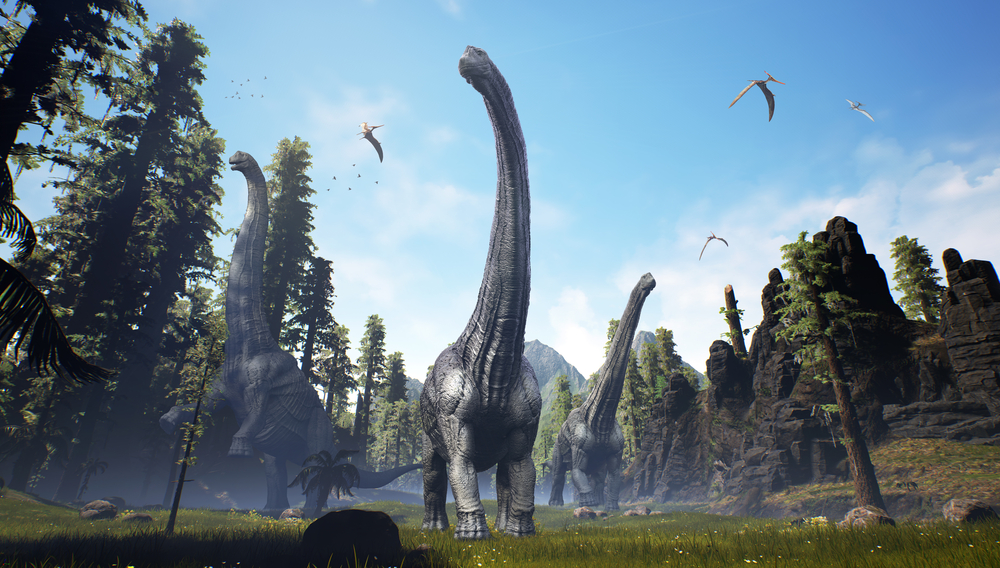For over 130 million years, our planet was dominated by diverse and extraordinary reptiles known as dinosaurs. During the Late Triassic Period, roughly 245 to 235 million years ago, the first non-avian dinosaurs began to emerge. Diverging from early reptiles, dinosaurs diversified during the Jurassic and Cretaceous Periods, bringing about hundreds of unique species, including some of the most enormous monsters to ever walk the Earth. But other strange and fascinating animals lived on our planet long before the dawn of the dinosaurs. Roughly a hundred million years earlier, the Earth was flooded by warm, shallow waters, producing swamps, wetlands, and vast tropical forests. These rich, highly oxygenized ecosystems were home to the gigantic relatives of modern arthropods. Bird-sized dragonflies swooped down from the skies, capturing small insects in their spiny legs. Prehistoric millipedes, as long as small cars, crawled through swampy underbrush, possibly snacking on clubmoss and sporophylls. Some of the largest arthropods were eurypterids or “sea scorpions.” The earliest Eurypterids probably lived in the ocean, using their wide appendages to gracefully navigate the salty shallows. Eventually, eurypterids adapted to live in both fresh and brackish water habitats in marshes and river deltas. There, giant species swelled to over two meters long. The largest was Jaekelopterus, an agile and powerful hunter that crushed its prey in its oversized claws.
Living alongside giant arthropods, amphibians were some of the first vertebrates with legs adapted to walking on land. Diplocaulus was like the frog of its time—super common and hard to miss, a salamander-like animal with a distinct, boomerang-shaped skull. Diplocaulus probably lived in swampy ecosystems around bodies of water. Preying upon insects, gastropods, and small fish, Diplocaulus probably used its weirdly shaped head to glide through water more smoothly and surprise its prey from below. Amphibians, like Diplocaulus, laid shell-less eggs, so they were mostly bound to bodies of water. However, new vertebrates called amniotes were surviving and reproducing further from the water’s edge. The evolution of hard-shelled amniotic eggs allowed amniotes to explore and populate a diverse world of terrestrial flora. In these thriving ecosystems, lizard-like animals filled new ecological niches, setting the stage for critical evolutions in terrestrial life. Around the same time, our planet underwent significant and widespread geological changes. The main landmasses on Earth were pulling together into a C-shaped supercontinent called Pangea. Over hundreds of millions of years, continental movements altered coastlines, closed seaways, and created giant mountain ranges like the Appalachians. Terrestrial ecosystems gradually became more isolated from seacoasts. The world’s rainforests and wetlands shrank, and Pangea’s climate grew hotter and more arid, enabling unprecedented diversification of terrestrial life. Seed plants with fronds and woody trunks grew in tropical and subtropical habitats, high in oxygen and teeming with terrestrial life. The early relatives of grasshoppers, crickets, and locusts bounded between branches and hanging vines. During the Permian era, beetles had a habit of gnawing on the woody parts of trees that were losing their vitality. Early reptiles, called sauropsids, scuttled across the forest floor, taking shelter in fallen branches and mossy underbrush.
Pangea was also home to giant, sail-backed synapsids, like Dimetrodon, an apex predator stretching up to 4.5 meters from head to tail. Superficially reptilian, Dimetrodon had sprawling legs and differentiated teeth, but its most distinctive feature was a tall dorsal sail, which it likely used to keep its body temperature in balance. These innovations enabled Dimetrodon to thrive in subtropical deserts and swamps, where it likely fed on early reptiles and amphibians like Diplocaulus. Even though Dimetrodon has that classic dinosaur look with its sail and size, it’s actually more like a distant relative of mammals. Not until the middle Permian did any creatures start to resemble the mammals we know today. In the early days, therapsids were overshadowed by larger hunters like Dimetrodon. They started out as smaller, lean creatures but eventually evolved into larger and more dominant beings. Eventually, bulky herbivores with tusks and horny beaks filled the world’s forests, chomping on low-hanging branches and ferns. Giant carnivores ambushed their prey with crushing jaws and saber-like teeth. One of the biggest therapsids from the Permian era was a massive, awkward animal called Moschops. Found in the semi-arid regions of modern-day South Africa, Moschops was a stalky plant-eater, measuring over two meters long and weighing upward of 320 kilograms. To carry its hulking body, Moschops had notably large shoulders and wide-set elbows, plus an incredibly thick skull. Paleontologists believe males competed for mates by clashing their thick heads together, similar to modern-day rams.
While therapsids dominated the Permian Period, Pangea’s forests and deserts were also populated by new species of reptiles. The earliest genera had long necks and sprawling bodies, but these animals quietly diversified throughout the Late Permian. Early reptiles may have struggled to compete with therapsids like dicynodonts and gorgonopsians, leading some species to become highly specialized. Weigeltisaurids evolved wing-like membranes that allowed them to fly between trees and potentially snatch insects out of the air. Semi-aquatic reptiles like Claudiosaurus found their ecological niches underwater. Evolving webbed feet and an undulating body, these reptiles lived among spiny fishes, conodonts, and even the relatives of true sharks. Before the end-Permian boundary, another significant group of vertebrates emerged in the arid regions of Pangea. Known as cynodonts, these advanced creatures had differentiated teeth, secondary palates, and primitive endothermic metabolisms, which made them highly adaptable to different environments. The earliest known cynodont was Procynosuchus, a semi-aquatic genus found in modern-day Germany and parts of Africa. Paleontologists hypothesize that Procynosuchus lived a lot like today’s otters. Using its long tail like a motor, it was likely a strong, agile swimmer, able to chase small fish through tangles of aquatic plants. After catching its dinner, Procynosuchus returned to dry land, where it may have rested and tended to its young. But the world in which Procynosuchus lived was steadily approaching one of the greatest disasters in Earth’s history.
About 252 million years ago, near the end-Permian boundary, our planet experienced a prolonged mass extinction known as the Permian-Triassic or P-T Extinction Event. Over hundreds of thousands, possibly millions of years, the P-T Extinction Event eradicated roughly 95% of marine species, 70% of terrestrial vertebrates, and entire orders of insects, making it the largest extinction event of all time. The exact cause of the P-T Extinction Event remains unknown, though it was almost certainly influenced by major volcanic eruptions around the Siberian Traps. Nonstop volcanic eruptions over the years likely saturated the atmosphere with carbon dioxide, raising surface and ocean temperatures to inhospitable extremes. Acid rain may have poured down on the surface as wildfires raged through dry forests and subtropical deserts. The Siberian Traps probably launched enough debris into the atmosphere to block out the sun and immerse the world in darkness, thus starving many species that relied on sunlight to survive. In this dark, scorching world, many shallow-water ecosystems collapsed due to catastrophic losses of aquatic plants, corals, and echinoderms. Some marine animals, like eurypterids and trilobites, vanished entirely. Even those groups that survived, like bony fishes and brachiopods, were pushed to the brink. The P-T Extinction Event also threatened terrestrial ecosystems, significantly reducing the biodiversity of terrestrial flora and fauna. Resilient plants, like ferns and conifers, managed to survive the P-T Extinction Event, but many terrestrial animals did not. Sail-backed synapsids, saber-toothed gorgonopsians, and some heavy herbivores like Moschops vanished from the fossil record. Only a few resilient synapsids crossed the end-Permian boundary by adapting to the harsh conditions of the very early Triassic.
Back then, Pangea was a challenging and unstable place, but it wasn’t entirely unlike how it was in the Late Permian. After the P-T Extinction Event, the climate was likely warmer and drier, with hot summers and cold winters. Vast rainless deserts and open prairies stretched across the dry equatorial regions of Pangea. At northern latitudes, sprawling forests were populated by shrubs, woody vines, and tall conifer trees. In these familiar biomes, therapsids were by far the most common terrestrial vertebrates. Herbivorous dicynodonts like Lystrosaurus grazed on shrubs and underbrush, while smaller cynodonts burrowed into the ground, protecting their young from the planet’s more volatile climate. Beyond the Early Triassic, Therapsids began to disappear, and reptiles gradually took control of the land, air, and sea. Marine predators, like nothosaurs and armored placodonts, ruled oceanic ecosystems. Meanwhile, terrestrial reptiles became increasingly numerous and diverse. Soon, all kinds of strange and fascinating creatures walked the Earth. There were some with necks just as long as their bodies. Others had humongous heads and bone-crushing jaws. These odd creatures ushered in a new age of reptilian dominance, beginning with the emergence of the first true dinosaurs. Exactly which dinosaur species came first remains a subject of controversy.
Around 233 to 230 million years ago, during the Late Triassic period, dinosaurs such as Eoraptor and Herrerasaurus started to appear.Not long after, bipedal therapods darted across open prairies, hunting smaller vertebrates with their razor-sharp teeth. Prosauropods stood on their hind legs and grazed from the high branches of towering conifers. These and other dinosaurs diverged into more than 700 known species and likely thousands more yet to be discovered. In many ways, the dinosaurs represent one chapter in a much longer story that began millions of years earlier. Before the dawn of the dinosaurs, our planet experienced significant geological changes, climate disasters, and devastating extinctions. Even with all that going on, the Late Paleozoic was a time when life really started to take off and diversify, paving the way for dinosaurs as well as the millions of species we know today.

